CLAUDIA CASARINO: "EVERYTHING IS BORN FROM PERSONAL AND FAMILY NARRATIVES"
Paraguayan artist Claudia Casarino will be part of the opening of the Pinta Sud | ASU 2024 art week, from August 5 to 11, 2024. In a conversation with Arte al Día, she explains her link with Paraguay, the body and clothing to tell stories that reinterpret the universe of women.
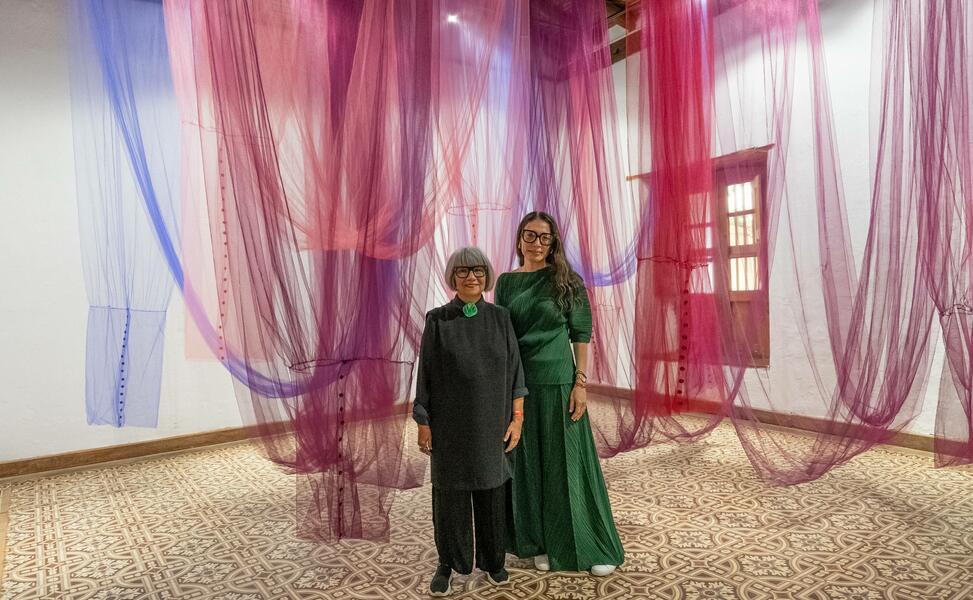
What is the place of materiality in your work? From where do you approach it?
Matter is concept. Each part of the work is selected with almost surgical premeditation. I cannot separate the materials from the discourse, the materials are the discourse as well. In my pieces there is little room for chance.
Clothing and textiles are prominent elements in your artwork. How do you think these objects can challenge or redefine traditional perceptions of the body and gender identity?
The history of dress is also the history of oppressions. Through cultural objects we can approach other ways of interpreting the past and the political reasons behind each decision/imposition of use or custom.
I find in dresses a very eloquent way to talk about violence, inequality and its consequences.
Do you seek to generate conversation and awareness about issues such as gender violence and structural oppression through your work?
Always, from day one. Although my feminism has been mutating from a very Eurocentric vision in my early training, mostly reading white and academic women authors, in recent years I have had the privilege of knowing what women from other regions of the planet think and do, from the global south, from South America and their ways of seeing and understanding us, of inscribing our narratives.
What does Paraguay mean in your production? Understanding that your work reflects on peripheries, borders and forced transits.
Everything is born from Paraguay, because everything is born from personal and family narratives. This territory where my mother was born, my grandmothers, where I was born, has traced the path of my production. But nevertheless, the work can be read, it can be accessed from other territories, because the experiences are similar.
This edition of Pinta Sud features an exhibition of your work at the Manzana de la Rivera, what challenges and opportunities did you encounter in presenting your work in such a unique environment and how do you think this influences the viewer's perception? How do you see the evolution of your work in the context of your career and previous exhibitions by presenting your work in this venue?
It has been many years since I have exhibited at the Manzana de la Rivera and this is the first time Adriana Almada is curating an exhibition of mine. I enjoyed the process very much. I usually work with limited timeframes, which for me this month has been intense, but at the same time more relaxed than in other exhibitions.
May interest you
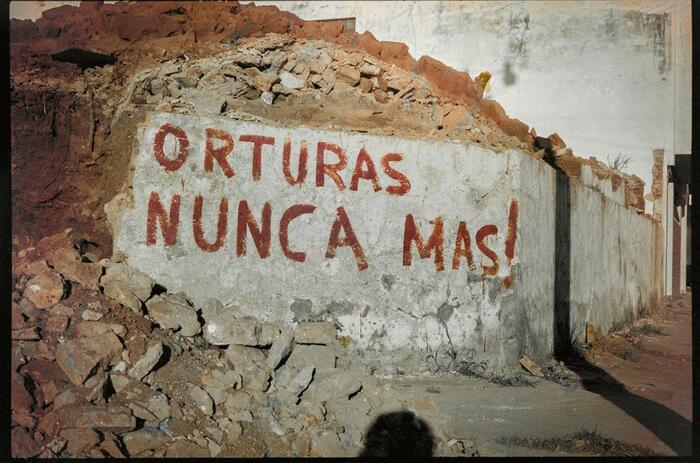
Artística - Espacio de arte presents from August 5 the artist Osvaldo Salerno with the exhibition of photographs El retorno (The Return), within Pinta Sud | ASU art week. It is curated by Javier Medina Verdolini and has additional texts by Ticio Escobar.
IMAGES THAT REMAIN FOR WHAT WAS SAID – OSVALDO SALERNO IN ARTÍSTICA

Artística - Espacio de arte presents from August 5 the artist Osvaldo Salerno with the exhibition of photographs El retorno (The Return), within Pinta Sud | ASU art week. It is curated by Javier Medina Verdolini and has additional texts by Ticio Escobar.
IMAGES THAT REMAIN FOR WHAT WAS SAID – OSVALDO SALERNO IN ARTÍSTICA
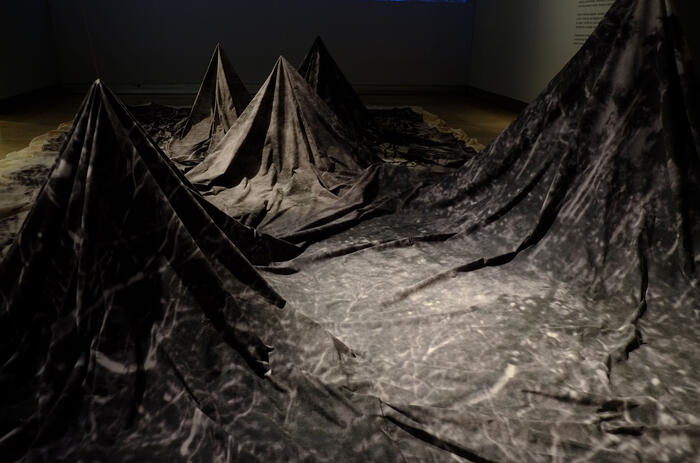
Within the context of Pinta Sud | ASU 2024, Viedma gallery presents from August 6 the installation El Bosque que vuela: ficciones en torno a Ogwa (The Forest that flies: fictions around Ogwa) by the artist Joaquín Sánchez. It is curated by Adriana Almada.

In the next edition of Pinta Sud | ASU 2024 -to be held from August 5 to 11, 2024 in Asuncion, Paraguay- the FORO lecture series will be one of the key spaces to delve into Latin American curatorial practice. Curated by Adriana Almada and Irene Gelfman, FORO will feature international guests such as Inés Katzenstein, Isabella Lenzi, Raphael Fonseca, among others.
LATIN AMERICAN CURATORIAL PRACTICE AT PINTA Sud | ASU 2024
In the next edition of Pinta Sud | ASU 2024 -to be held from August 5 to 11, 2024 in Asuncion, Paraguay- the FORO lecture series will be one of the key spaces to delve into Latin American curatorial practice. Curated by Adriana Almada and Irene Gelfman, FORO will feature international guests such as Inés Katzenstein, Isabella Lenzi, Raphael Fonseca, among others.
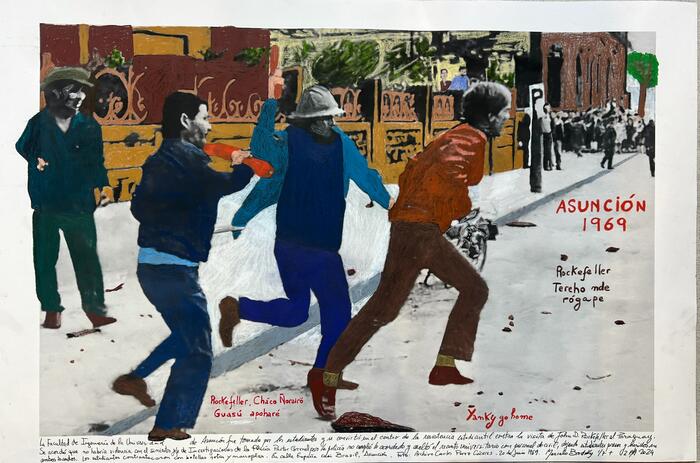
The Museo del Barro will present, in the context of Pinta Sud | ASU 2024, the exhibition The Colors of Resistance by artist Marcelo Brodsky. It is under the curatorship of Ticio Escobar.
THE COLORS OF THE RESISTANCE: MARCELO BRODSKY AT MUSEO DEL BARRO
The Museo del Barro will present, in the context of Pinta Sud | ASU 2024, the exhibition The Colors of Resistance by artist Marcelo Brodsky. It is under the curatorship of Ticio Escobar.

The next Pompidou Museum project in Foz do Iguaçu will be presented by Luciana Pereira, Secretary of Culture of the State of Paraná, Brazil, at the Pinta Sud | ASU conference, to be held at the Casa de la Integración (CAF) on August 8, 2024. This will be the first Pompidou Center in Latin America.
THE POMPIDOU MUSEUM PROJECT IN FOZ DO IGUAZU WILL BE PRESENTED AT PINTA Sud | ASU 2024
The next Pompidou Museum project in Foz do Iguaçu will be presented by Luciana Pereira, Secretary of Culture of the State of Paraná, Brazil, at the Pinta Sud | ASU conference, to be held at the Casa de la Integración (CAF) on August 8, 2024. This will be the first Pompidou Center in Latin America.

Pinta Sud | ASU presents the third and final edition of Asunción’s Art Week, taking place from August 5-11, 2024. The event will feature art exhibitions, events, and various activities free and open to the public, offering seven days of artistic celebration throughout the city.
ASUNCIÓN IN THE SPOTLIGHT: LAST EDITION OF PINTA SUD
Pinta Sud | ASU presents the third and final edition of Asunción’s Art Week, taking place from August 5-11, 2024. The event will feature art exhibitions, events, and various activities free and open to the public, offering seven days of artistic celebration throughout the city.

Luciérnagas humanas al ras de la tierra (Human fireflies at ground level) is a video-installation that the artist Marcos Benítez presents at the Paraguayan-German Cultural Institute. It is curated by Adriana Almada and will be part of the art week of Asunción Pinta Sud | ASU 2024.
THE INSTALLATION OF MARCOS BENITEZ AT ICPA
Luciérnagas humanas al ras de la tierra (Human fireflies at ground level) is a video-installation that the artist Marcos Benítez presents at the Paraguayan-German Cultural Institute. It is curated by Adriana Almada and will be part of the art week of Asunción Pinta Sud | ASU 2024.
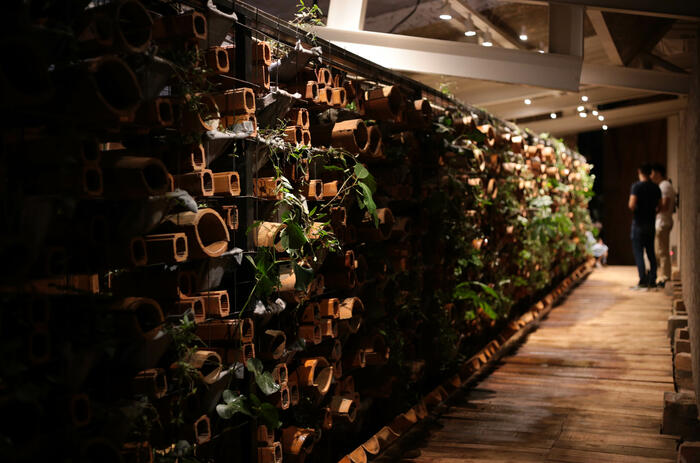
Fundación Texo presents the return of its most important and ambitious program, #Seleccion5. This initiative highlights the value of contemporary Paraguayan architecture, presenting an exhibition project of outstanding local studios and professionals.
TEXO FOUNDATION AND THE ARCHITECTURE PROJECT #SELECCION5
Fundación Texo presents the return of its most important and ambitious program, #Seleccion5. This initiative highlights the value of contemporary Paraguayan architecture, presenting an exhibition project of outstanding local studios and professionals.
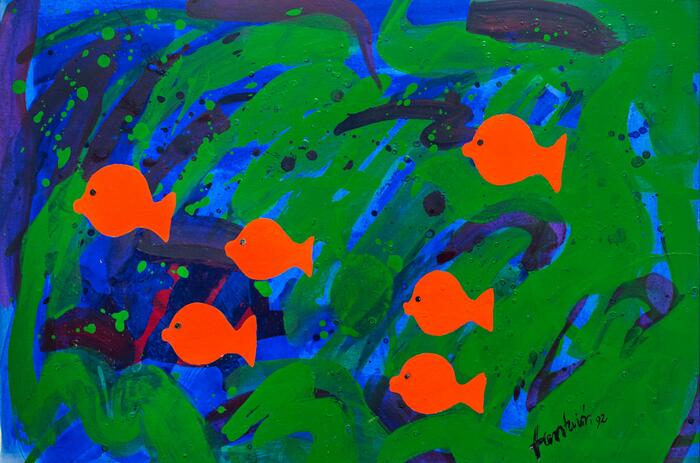
Paraguay is rarely mentioned when discussing the global art market, but this might change in the coming years due to its growing activity in the contemporary art sector. This activity is primarily driven by local galleries, which, aware of the cultural isolation the country has experienced for many years, are actively promoting local collecting and seeking to promote their artists through fairs and participation in events like the current Pinta Sud|ASU.
PARAGUAY: AN EXPANDING ART MARKET
Paraguay is rarely mentioned when discussing the global art market, but this might change in the coming years due to its growing activity in the contemporary art sector. This activity is primarily driven by local galleries, which, aware of the cultural isolation the country has experienced for many years, are actively promoting local collecting and seeking to promote their artists through fairs and participation in events like the current Pinta Sud|ASU.
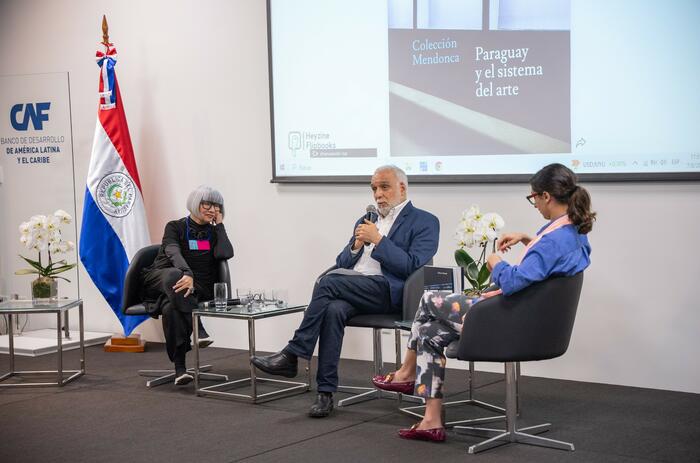
Within the framework of Pinta Sud | ASU 2024 FORO conversatory, Ticio Escobar - moderated by Irene Gelfman - participated in the exclusive presentation of the book "Colección Mendonca. Paraguay and the art system", by Adriana Almada. The book was presented at CAF - Development Bank of Latin America and the Caribbean.
PARAGUAY AND THE ART SYSTEM
Within the framework of Pinta Sud | ASU 2024 FORO conversatory, Ticio Escobar - moderated by Irene Gelfman - participated in the exclusive presentation of the book "Colección Mendonca. Paraguay and the art system", by Adriana Almada. The book was presented at CAF - Development Bank of Latin America and the Caribbean.
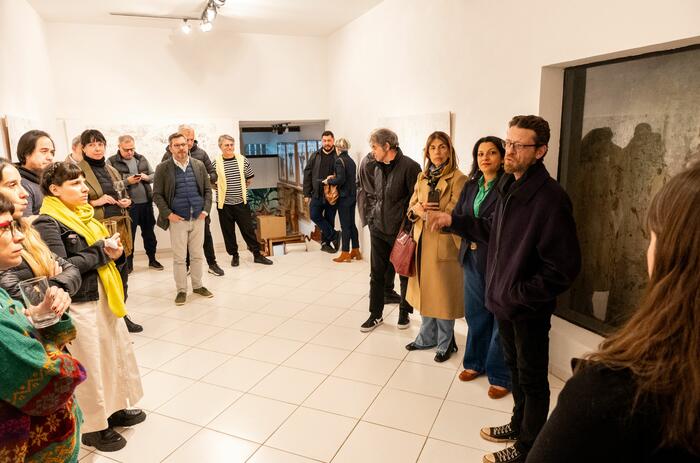
The third and last edition of Art Week Asuncion presented by Pinta Sud | ASU starts today August 5 with an ambitious cultural program, curated by Adriana Almada and accompanied by Irene Gelfman, featuring exhibitions, curatorial programs, lecture series and events.
PINTA Sud | ASU ART WEEK IN ASUNCION
The third and last edition of Art Week Asuncion presented by Pinta Sud | ASU starts today August 5 with an ambitious cultural program, curated by Adriana Almada and accompanied by Irene Gelfman, featuring exhibitions, curatorial programs, lecture series and events.
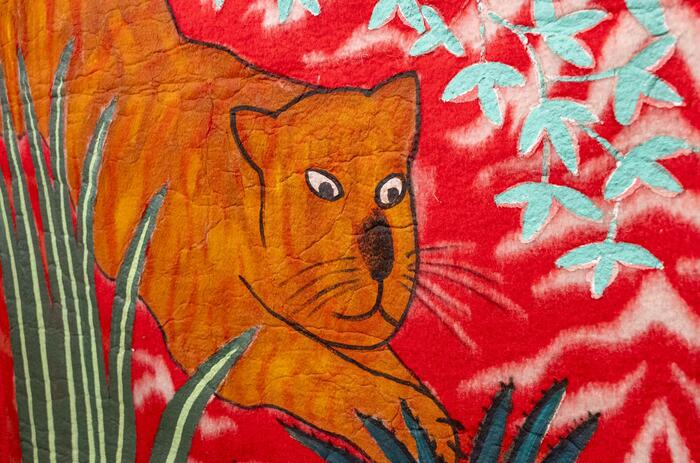
Pinta Sud | ASU 2024 presented at the Casa Mayor gallery the exhibition Warm Heart, with works by the Paraguayan artist Feliciano Centurión. It is a collection of works from different periods of his career and is curated by Irene Gelfman.
FELICIANO CENTURIÓN'S WARM HEART
Pinta Sud | ASU 2024 presented at the Casa Mayor gallery the exhibition Warm Heart, with works by the Paraguayan artist Feliciano Centurión. It is a collection of works from different periods of his career and is curated by Irene Gelfman.

Nélida Mendoza is an artist who was born in Paraguay, but lived in several parts of the world, including Argentina and Italy. She is presenting the exhibition Fuerte Olimpo and Other Stories at the gallery K / Arte y Naturaleza during the Pinta Sud | ASU 2024 art week.
NÉLIDA MENDOZA'S IDENTITY SYSTEMS
Nélida Mendoza is an artist who was born in Paraguay, but lived in several parts of the world, including Argentina and Italy. She is presenting the exhibition Fuerte Olimpo and Other Stories at the gallery K / Arte y Naturaleza during the Pinta Sud | ASU 2024 art week.

The third edition of Pinta Sud | ASU 2024 came to an end after a day of ceramic workshop in Itá with the renowned ceramist Julia Isídrez.
PINTA Sud | ASU CLOSED ITS THIRD EDITION AT JULIA ISÍDREZ'S WORKSHOP IN ITÁ
The third edition of Pinta Sud | ASU 2024 came to an end after a day of ceramic workshop in Itá with the renowned ceramist Julia Isídrez.

Artística - Espacio de arte presents from August 5 the artist Osvaldo Salerno with the exhibition of photographs El retorno (The Return), within Pinta Sud | ASU art week. It is curated by Javier Medina Verdolini and has additional texts by Ticio Escobar.
IMAGES THAT REMAIN FOR WHAT WAS SAID – OSVALDO SALERNO IN ARTÍSTICA

Within the context of Pinta Sud | ASU 2024, Viedma gallery presents from August 6 the installation El Bosque que vuela: ficciones en torno a Ogwa (The Forest that flies: fictions around Ogwa) by the artist Joaquín Sánchez. It is curated by Adriana Almada.

In the next edition of Pinta Sud | ASU 2024 -to be held from August 5 to 11, 2024 in Asuncion, Paraguay- the FORO lecture series will be one of the key spaces to delve into Latin American curatorial practice. Curated by Adriana Almada and Irene Gelfman, FORO will feature international guests such as Inés Katzenstein, Isabella Lenzi, Raphael Fonseca, among others.
LATIN AMERICAN CURATORIAL PRACTICE AT PINTA Sud | ASU 2024
In the next edition of Pinta Sud | ASU 2024 -to be held from August 5 to 11, 2024 in Asuncion, Paraguay- the FORO lecture series will be one of the key spaces to delve into Latin American curatorial practice. Curated by Adriana Almada and Irene Gelfman, FORO will feature international guests such as Inés Katzenstein, Isabella Lenzi, Raphael Fonseca, among others.

The Museo del Barro will present, in the context of Pinta Sud | ASU 2024, the exhibition The Colors of Resistance by artist Marcelo Brodsky. It is under the curatorship of Ticio Escobar.
THE COLORS OF THE RESISTANCE: MARCELO BRODSKY AT MUSEO DEL BARRO
The Museo del Barro will present, in the context of Pinta Sud | ASU 2024, the exhibition The Colors of Resistance by artist Marcelo Brodsky. It is under the curatorship of Ticio Escobar.

The next Pompidou Museum project in Foz do Iguaçu will be presented by Luciana Pereira, Secretary of Culture of the State of Paraná, Brazil, at the Pinta Sud | ASU conference, to be held at the Casa de la Integración (CAF) on August 8, 2024. This will be the first Pompidou Center in Latin America.
THE POMPIDOU MUSEUM PROJECT IN FOZ DO IGUAZU WILL BE PRESENTED AT PINTA Sud | ASU 2024
The next Pompidou Museum project in Foz do Iguaçu will be presented by Luciana Pereira, Secretary of Culture of the State of Paraná, Brazil, at the Pinta Sud | ASU conference, to be held at the Casa de la Integración (CAF) on August 8, 2024. This will be the first Pompidou Center in Latin America.

Pinta Sud | ASU presents the third and final edition of Asunción’s Art Week, taking place from August 5-11, 2024. The event will feature art exhibitions, events, and various activities free and open to the public, offering seven days of artistic celebration throughout the city.
ASUNCIÓN IN THE SPOTLIGHT: LAST EDITION OF PINTA SUD
Pinta Sud | ASU presents the third and final edition of Asunción’s Art Week, taking place from August 5-11, 2024. The event will feature art exhibitions, events, and various activities free and open to the public, offering seven days of artistic celebration throughout the city.

Luciérnagas humanas al ras de la tierra (Human fireflies at ground level) is a video-installation that the artist Marcos Benítez presents at the Paraguayan-German Cultural Institute. It is curated by Adriana Almada and will be part of the art week of Asunción Pinta Sud | ASU 2024.
THE INSTALLATION OF MARCOS BENITEZ AT ICPA
Luciérnagas humanas al ras de la tierra (Human fireflies at ground level) is a video-installation that the artist Marcos Benítez presents at the Paraguayan-German Cultural Institute. It is curated by Adriana Almada and will be part of the art week of Asunción Pinta Sud | ASU 2024.

Fundación Texo presents the return of its most important and ambitious program, #Seleccion5. This initiative highlights the value of contemporary Paraguayan architecture, presenting an exhibition project of outstanding local studios and professionals.
TEXO FOUNDATION AND THE ARCHITECTURE PROJECT #SELECCION5
Fundación Texo presents the return of its most important and ambitious program, #Seleccion5. This initiative highlights the value of contemporary Paraguayan architecture, presenting an exhibition project of outstanding local studios and professionals.

Paraguay is rarely mentioned when discussing the global art market, but this might change in the coming years due to its growing activity in the contemporary art sector. This activity is primarily driven by local galleries, which, aware of the cultural isolation the country has experienced for many years, are actively promoting local collecting and seeking to promote their artists through fairs and participation in events like the current Pinta Sud|ASU.
PARAGUAY: AN EXPANDING ART MARKET
Paraguay is rarely mentioned when discussing the global art market, but this might change in the coming years due to its growing activity in the contemporary art sector. This activity is primarily driven by local galleries, which, aware of the cultural isolation the country has experienced for many years, are actively promoting local collecting and seeking to promote their artists through fairs and participation in events like the current Pinta Sud|ASU.

Within the framework of Pinta Sud | ASU 2024 FORO conversatory, Ticio Escobar - moderated by Irene Gelfman - participated in the exclusive presentation of the book "Colección Mendonca. Paraguay and the art system", by Adriana Almada. The book was presented at CAF - Development Bank of Latin America and the Caribbean.
PARAGUAY AND THE ART SYSTEM
Within the framework of Pinta Sud | ASU 2024 FORO conversatory, Ticio Escobar - moderated by Irene Gelfman - participated in the exclusive presentation of the book "Colección Mendonca. Paraguay and the art system", by Adriana Almada. The book was presented at CAF - Development Bank of Latin America and the Caribbean.

The third and last edition of Art Week Asuncion presented by Pinta Sud | ASU starts today August 5 with an ambitious cultural program, curated by Adriana Almada and accompanied by Irene Gelfman, featuring exhibitions, curatorial programs, lecture series and events.
PINTA Sud | ASU ART WEEK IN ASUNCION
The third and last edition of Art Week Asuncion presented by Pinta Sud | ASU starts today August 5 with an ambitious cultural program, curated by Adriana Almada and accompanied by Irene Gelfman, featuring exhibitions, curatorial programs, lecture series and events.

Pinta Sud | ASU 2024 presented at the Casa Mayor gallery the exhibition Warm Heart, with works by the Paraguayan artist Feliciano Centurión. It is a collection of works from different periods of his career and is curated by Irene Gelfman.
FELICIANO CENTURIÓN'S WARM HEART
Pinta Sud | ASU 2024 presented at the Casa Mayor gallery the exhibition Warm Heart, with works by the Paraguayan artist Feliciano Centurión. It is a collection of works from different periods of his career and is curated by Irene Gelfman.

Nélida Mendoza is an artist who was born in Paraguay, but lived in several parts of the world, including Argentina and Italy. She is presenting the exhibition Fuerte Olimpo and Other Stories at the gallery K / Arte y Naturaleza during the Pinta Sud | ASU 2024 art week.
NÉLIDA MENDOZA'S IDENTITY SYSTEMS
Nélida Mendoza is an artist who was born in Paraguay, but lived in several parts of the world, including Argentina and Italy. She is presenting the exhibition Fuerte Olimpo and Other Stories at the gallery K / Arte y Naturaleza during the Pinta Sud | ASU 2024 art week.

The third edition of Pinta Sud | ASU 2024 came to an end after a day of ceramic workshop in Itá with the renowned ceramist Julia Isídrez.
PINTA Sud | ASU CLOSED ITS THIRD EDITION AT JULIA ISÍDREZ'S WORKSHOP IN ITÁ
The third edition of Pinta Sud | ASU 2024 came to an end after a day of ceramic workshop in Itá with the renowned ceramist Julia Isídrez.

Artística - Espacio de arte presents from August 5 the artist Osvaldo Salerno with the exhibition of photographs El retorno (The Return), within Pinta Sud | ASU art week. It is curated by Javier Medina Verdolini and has additional texts by Ticio Escobar.
IMAGES THAT REMAIN FOR WHAT WAS SAID – OSVALDO SALERNO IN ARTÍSTICA

Within the context of Pinta Sud | ASU 2024, Viedma gallery presents from August 6 the installation El Bosque que vuela: ficciones en torno a Ogwa (The Forest that flies: fictions around Ogwa) by the artist Joaquín Sánchez. It is curated by Adriana Almada.

In the next edition of Pinta Sud | ASU 2024 -to be held from August 5 to 11, 2024 in Asuncion, Paraguay- the FORO lecture series will be one of the key spaces to delve into Latin American curatorial practice. Curated by Adriana Almada and Irene Gelfman, FORO will feature international guests such as Inés Katzenstein, Isabella Lenzi, Raphael Fonseca, among others.
LATIN AMERICAN CURATORIAL PRACTICE AT PINTA Sud | ASU 2024
In the next edition of Pinta Sud | ASU 2024 -to be held from August 5 to 11, 2024 in Asuncion, Paraguay- the FORO lecture series will be one of the key spaces to delve into Latin American curatorial practice. Curated by Adriana Almada and Irene Gelfman, FORO will feature international guests such as Inés Katzenstein, Isabella Lenzi, Raphael Fonseca, among others.

The Museo del Barro will present, in the context of Pinta Sud | ASU 2024, the exhibition The Colors of Resistance by artist Marcelo Brodsky. It is under the curatorship of Ticio Escobar.
THE COLORS OF THE RESISTANCE: MARCELO BRODSKY AT MUSEO DEL BARRO
The Museo del Barro will present, in the context of Pinta Sud | ASU 2024, the exhibition The Colors of Resistance by artist Marcelo Brodsky. It is under the curatorship of Ticio Escobar.

The next Pompidou Museum project in Foz do Iguaçu will be presented by Luciana Pereira, Secretary of Culture of the State of Paraná, Brazil, at the Pinta Sud | ASU conference, to be held at the Casa de la Integración (CAF) on August 8, 2024. This will be the first Pompidou Center in Latin America.
THE POMPIDOU MUSEUM PROJECT IN FOZ DO IGUAZU WILL BE PRESENTED AT PINTA Sud | ASU 2024
The next Pompidou Museum project in Foz do Iguaçu will be presented by Luciana Pereira, Secretary of Culture of the State of Paraná, Brazil, at the Pinta Sud | ASU conference, to be held at the Casa de la Integración (CAF) on August 8, 2024. This will be the first Pompidou Center in Latin America.

Pinta Sud | ASU presents the third and final edition of Asunción’s Art Week, taking place from August 5-11, 2024. The event will feature art exhibitions, events, and various activities free and open to the public, offering seven days of artistic celebration throughout the city.
ASUNCIÓN IN THE SPOTLIGHT: LAST EDITION OF PINTA SUD
Pinta Sud | ASU presents the third and final edition of Asunción’s Art Week, taking place from August 5-11, 2024. The event will feature art exhibitions, events, and various activities free and open to the public, offering seven days of artistic celebration throughout the city.

Luciérnagas humanas al ras de la tierra (Human fireflies at ground level) is a video-installation that the artist Marcos Benítez presents at the Paraguayan-German Cultural Institute. It is curated by Adriana Almada and will be part of the art week of Asunción Pinta Sud | ASU 2024.
THE INSTALLATION OF MARCOS BENITEZ AT ICPA
Luciérnagas humanas al ras de la tierra (Human fireflies at ground level) is a video-installation that the artist Marcos Benítez presents at the Paraguayan-German Cultural Institute. It is curated by Adriana Almada and will be part of the art week of Asunción Pinta Sud | ASU 2024.

Fundación Texo presents the return of its most important and ambitious program, #Seleccion5. This initiative highlights the value of contemporary Paraguayan architecture, presenting an exhibition project of outstanding local studios and professionals.
TEXO FOUNDATION AND THE ARCHITECTURE PROJECT #SELECCION5
Fundación Texo presents the return of its most important and ambitious program, #Seleccion5. This initiative highlights the value of contemporary Paraguayan architecture, presenting an exhibition project of outstanding local studios and professionals.

Paraguay is rarely mentioned when discussing the global art market, but this might change in the coming years due to its growing activity in the contemporary art sector. This activity is primarily driven by local galleries, which, aware of the cultural isolation the country has experienced for many years, are actively promoting local collecting and seeking to promote their artists through fairs and participation in events like the current Pinta Sud|ASU.
PARAGUAY: AN EXPANDING ART MARKET
Paraguay is rarely mentioned when discussing the global art market, but this might change in the coming years due to its growing activity in the contemporary art sector. This activity is primarily driven by local galleries, which, aware of the cultural isolation the country has experienced for many years, are actively promoting local collecting and seeking to promote their artists through fairs and participation in events like the current Pinta Sud|ASU.

Within the framework of Pinta Sud | ASU 2024 FORO conversatory, Ticio Escobar - moderated by Irene Gelfman - participated in the exclusive presentation of the book "Colección Mendonca. Paraguay and the art system", by Adriana Almada. The book was presented at CAF - Development Bank of Latin America and the Caribbean.
PARAGUAY AND THE ART SYSTEM
Within the framework of Pinta Sud | ASU 2024 FORO conversatory, Ticio Escobar - moderated by Irene Gelfman - participated in the exclusive presentation of the book "Colección Mendonca. Paraguay and the art system", by Adriana Almada. The book was presented at CAF - Development Bank of Latin America and the Caribbean.

The third and last edition of Art Week Asuncion presented by Pinta Sud | ASU starts today August 5 with an ambitious cultural program, curated by Adriana Almada and accompanied by Irene Gelfman, featuring exhibitions, curatorial programs, lecture series and events.
PINTA Sud | ASU ART WEEK IN ASUNCION
The third and last edition of Art Week Asuncion presented by Pinta Sud | ASU starts today August 5 with an ambitious cultural program, curated by Adriana Almada and accompanied by Irene Gelfman, featuring exhibitions, curatorial programs, lecture series and events.

Pinta Sud | ASU 2024 presented at the Casa Mayor gallery the exhibition Warm Heart, with works by the Paraguayan artist Feliciano Centurión. It is a collection of works from different periods of his career and is curated by Irene Gelfman.
FELICIANO CENTURIÓN'S WARM HEART
Pinta Sud | ASU 2024 presented at the Casa Mayor gallery the exhibition Warm Heart, with works by the Paraguayan artist Feliciano Centurión. It is a collection of works from different periods of his career and is curated by Irene Gelfman.

Nélida Mendoza is an artist who was born in Paraguay, but lived in several parts of the world, including Argentina and Italy. She is presenting the exhibition Fuerte Olimpo and Other Stories at the gallery K / Arte y Naturaleza during the Pinta Sud | ASU 2024 art week.
NÉLIDA MENDOZA'S IDENTITY SYSTEMS
Nélida Mendoza is an artist who was born in Paraguay, but lived in several parts of the world, including Argentina and Italy. She is presenting the exhibition Fuerte Olimpo and Other Stories at the gallery K / Arte y Naturaleza during the Pinta Sud | ASU 2024 art week.

The third edition of Pinta Sud | ASU 2024 came to an end after a day of ceramic workshop in Itá with the renowned ceramist Julia Isídrez.
PINTA Sud | ASU CLOSED ITS THIRD EDITION AT JULIA ISÍDREZ'S WORKSHOP IN ITÁ
The third edition of Pinta Sud | ASU 2024 came to an end after a day of ceramic workshop in Itá with the renowned ceramist Julia Isídrez.

Artística - Espacio de arte presents from August 5 the artist Osvaldo Salerno with the exhibition of photographs El retorno (The Return), within Pinta Sud | ASU art week. It is curated by Javier Medina Verdolini and has additional texts by Ticio Escobar.
IMAGES THAT REMAIN FOR WHAT WAS SAID – OSVALDO SALERNO IN ARTÍSTICA

Within the context of Pinta Sud | ASU 2024, Viedma gallery presents from August 6 the installation El Bosque que vuela: ficciones en torno a Ogwa (The Forest that flies: fictions around Ogwa) by the artist Joaquín Sánchez. It is curated by Adriana Almada.

In the next edition of Pinta Sud | ASU 2024 -to be held from August 5 to 11, 2024 in Asuncion, Paraguay- the FORO lecture series will be one of the key spaces to delve into Latin American curatorial practice. Curated by Adriana Almada and Irene Gelfman, FORO will feature international guests such as Inés Katzenstein, Isabella Lenzi, Raphael Fonseca, among others.
LATIN AMERICAN CURATORIAL PRACTICE AT PINTA Sud | ASU 2024
In the next edition of Pinta Sud | ASU 2024 -to be held from August 5 to 11, 2024 in Asuncion, Paraguay- the FORO lecture series will be one of the key spaces to delve into Latin American curatorial practice. Curated by Adriana Almada and Irene Gelfman, FORO will feature international guests such as Inés Katzenstein, Isabella Lenzi, Raphael Fonseca, among others.

The Museo del Barro will present, in the context of Pinta Sud | ASU 2024, the exhibition The Colors of Resistance by artist Marcelo Brodsky. It is under the curatorship of Ticio Escobar.
THE COLORS OF THE RESISTANCE: MARCELO BRODSKY AT MUSEO DEL BARRO
The Museo del Barro will present, in the context of Pinta Sud | ASU 2024, the exhibition The Colors of Resistance by artist Marcelo Brodsky. It is under the curatorship of Ticio Escobar.

The next Pompidou Museum project in Foz do Iguaçu will be presented by Luciana Pereira, Secretary of Culture of the State of Paraná, Brazil, at the Pinta Sud | ASU conference, to be held at the Casa de la Integración (CAF) on August 8, 2024. This will be the first Pompidou Center in Latin America.
THE POMPIDOU MUSEUM PROJECT IN FOZ DO IGUAZU WILL BE PRESENTED AT PINTA Sud | ASU 2024
The next Pompidou Museum project in Foz do Iguaçu will be presented by Luciana Pereira, Secretary of Culture of the State of Paraná, Brazil, at the Pinta Sud | ASU conference, to be held at the Casa de la Integración (CAF) on August 8, 2024. This will be the first Pompidou Center in Latin America.

Pinta Sud | ASU presents the third and final edition of Asunción’s Art Week, taking place from August 5-11, 2024. The event will feature art exhibitions, events, and various activities free and open to the public, offering seven days of artistic celebration throughout the city.
ASUNCIÓN IN THE SPOTLIGHT: LAST EDITION OF PINTA SUD
Pinta Sud | ASU presents the third and final edition of Asunción’s Art Week, taking place from August 5-11, 2024. The event will feature art exhibitions, events, and various activities free and open to the public, offering seven days of artistic celebration throughout the city.

Luciérnagas humanas al ras de la tierra (Human fireflies at ground level) is a video-installation that the artist Marcos Benítez presents at the Paraguayan-German Cultural Institute. It is curated by Adriana Almada and will be part of the art week of Asunción Pinta Sud | ASU 2024.
THE INSTALLATION OF MARCOS BENITEZ AT ICPA
Luciérnagas humanas al ras de la tierra (Human fireflies at ground level) is a video-installation that the artist Marcos Benítez presents at the Paraguayan-German Cultural Institute. It is curated by Adriana Almada and will be part of the art week of Asunción Pinta Sud | ASU 2024.

Fundación Texo presents the return of its most important and ambitious program, #Seleccion5. This initiative highlights the value of contemporary Paraguayan architecture, presenting an exhibition project of outstanding local studios and professionals.
TEXO FOUNDATION AND THE ARCHITECTURE PROJECT #SELECCION5
Fundación Texo presents the return of its most important and ambitious program, #Seleccion5. This initiative highlights the value of contemporary Paraguayan architecture, presenting an exhibition project of outstanding local studios and professionals.

Paraguay is rarely mentioned when discussing the global art market, but this might change in the coming years due to its growing activity in the contemporary art sector. This activity is primarily driven by local galleries, which, aware of the cultural isolation the country has experienced for many years, are actively promoting local collecting and seeking to promote their artists through fairs and participation in events like the current Pinta Sud|ASU.
PARAGUAY: AN EXPANDING ART MARKET
Paraguay is rarely mentioned when discussing the global art market, but this might change in the coming years due to its growing activity in the contemporary art sector. This activity is primarily driven by local galleries, which, aware of the cultural isolation the country has experienced for many years, are actively promoting local collecting and seeking to promote their artists through fairs and participation in events like the current Pinta Sud|ASU.

Within the framework of Pinta Sud | ASU 2024 FORO conversatory, Ticio Escobar - moderated by Irene Gelfman - participated in the exclusive presentation of the book "Colección Mendonca. Paraguay and the art system", by Adriana Almada. The book was presented at CAF - Development Bank of Latin America and the Caribbean.
PARAGUAY AND THE ART SYSTEM
Within the framework of Pinta Sud | ASU 2024 FORO conversatory, Ticio Escobar - moderated by Irene Gelfman - participated in the exclusive presentation of the book "Colección Mendonca. Paraguay and the art system", by Adriana Almada. The book was presented at CAF - Development Bank of Latin America and the Caribbean.

The third and last edition of Art Week Asuncion presented by Pinta Sud | ASU starts today August 5 with an ambitious cultural program, curated by Adriana Almada and accompanied by Irene Gelfman, featuring exhibitions, curatorial programs, lecture series and events.
PINTA Sud | ASU ART WEEK IN ASUNCION
The third and last edition of Art Week Asuncion presented by Pinta Sud | ASU starts today August 5 with an ambitious cultural program, curated by Adriana Almada and accompanied by Irene Gelfman, featuring exhibitions, curatorial programs, lecture series and events.

Pinta Sud | ASU 2024 presented at the Casa Mayor gallery the exhibition Warm Heart, with works by the Paraguayan artist Feliciano Centurión. It is a collection of works from different periods of his career and is curated by Irene Gelfman.
FELICIANO CENTURIÓN'S WARM HEART
Pinta Sud | ASU 2024 presented at the Casa Mayor gallery the exhibition Warm Heart, with works by the Paraguayan artist Feliciano Centurión. It is a collection of works from different periods of his career and is curated by Irene Gelfman.

Nélida Mendoza is an artist who was born in Paraguay, but lived in several parts of the world, including Argentina and Italy. She is presenting the exhibition Fuerte Olimpo and Other Stories at the gallery K / Arte y Naturaleza during the Pinta Sud | ASU 2024 art week.
NÉLIDA MENDOZA'S IDENTITY SYSTEMS
Nélida Mendoza is an artist who was born in Paraguay, but lived in several parts of the world, including Argentina and Italy. She is presenting the exhibition Fuerte Olimpo and Other Stories at the gallery K / Arte y Naturaleza during the Pinta Sud | ASU 2024 art week.

The third edition of Pinta Sud | ASU 2024 came to an end after a day of ceramic workshop in Itá with the renowned ceramist Julia Isídrez.
PINTA Sud | ASU CLOSED ITS THIRD EDITION AT JULIA ISÍDREZ'S WORKSHOP IN ITÁ
The third edition of Pinta Sud | ASU 2024 came to an end after a day of ceramic workshop in Itá with the renowned ceramist Julia Isídrez.

Artística - Espacio de arte presents from August 5 the artist Osvaldo Salerno with the exhibition of photographs El retorno (The Return), within Pinta Sud | ASU art week. It is curated by Javier Medina Verdolini and has additional texts by Ticio Escobar.
IMAGES THAT REMAIN FOR WHAT WAS SAID – OSVALDO SALERNO IN ARTÍSTICA

Within the context of Pinta Sud | ASU 2024, Viedma gallery presents from August 6 the installation El Bosque que vuela: ficciones en torno a Ogwa (The Forest that flies: fictions around Ogwa) by the artist Joaquín Sánchez. It is curated by Adriana Almada.

In the next edition of Pinta Sud | ASU 2024 -to be held from August 5 to 11, 2024 in Asuncion, Paraguay- the FORO lecture series will be one of the key spaces to delve into Latin American curatorial practice. Curated by Adriana Almada and Irene Gelfman, FORO will feature international guests such as Inés Katzenstein, Isabella Lenzi, Raphael Fonseca, among others.
LATIN AMERICAN CURATORIAL PRACTICE AT PINTA Sud | ASU 2024
In the next edition of Pinta Sud | ASU 2024 -to be held from August 5 to 11, 2024 in Asuncion, Paraguay- the FORO lecture series will be one of the key spaces to delve into Latin American curatorial practice. Curated by Adriana Almada and Irene Gelfman, FORO will feature international guests such as Inés Katzenstein, Isabella Lenzi, Raphael Fonseca, among others.

The Museo del Barro will present, in the context of Pinta Sud | ASU 2024, the exhibition The Colors of Resistance by artist Marcelo Brodsky. It is under the curatorship of Ticio Escobar.
THE COLORS OF THE RESISTANCE: MARCELO BRODSKY AT MUSEO DEL BARRO
The Museo del Barro will present, in the context of Pinta Sud | ASU 2024, the exhibition The Colors of Resistance by artist Marcelo Brodsky. It is under the curatorship of Ticio Escobar.

The next Pompidou Museum project in Foz do Iguaçu will be presented by Luciana Pereira, Secretary of Culture of the State of Paraná, Brazil, at the Pinta Sud | ASU conference, to be held at the Casa de la Integración (CAF) on August 8, 2024. This will be the first Pompidou Center in Latin America.
THE POMPIDOU MUSEUM PROJECT IN FOZ DO IGUAZU WILL BE PRESENTED AT PINTA Sud | ASU 2024
The next Pompidou Museum project in Foz do Iguaçu will be presented by Luciana Pereira, Secretary of Culture of the State of Paraná, Brazil, at the Pinta Sud | ASU conference, to be held at the Casa de la Integración (CAF) on August 8, 2024. This will be the first Pompidou Center in Latin America.

Pinta Sud | ASU presents the third and final edition of Asunción’s Art Week, taking place from August 5-11, 2024. The event will feature art exhibitions, events, and various activities free and open to the public, offering seven days of artistic celebration throughout the city.
ASUNCIÓN IN THE SPOTLIGHT: LAST EDITION OF PINTA SUD
Pinta Sud | ASU presents the third and final edition of Asunción’s Art Week, taking place from August 5-11, 2024. The event will feature art exhibitions, events, and various activities free and open to the public, offering seven days of artistic celebration throughout the city.

Luciérnagas humanas al ras de la tierra (Human fireflies at ground level) is a video-installation that the artist Marcos Benítez presents at the Paraguayan-German Cultural Institute. It is curated by Adriana Almada and will be part of the art week of Asunción Pinta Sud | ASU 2024.
THE INSTALLATION OF MARCOS BENITEZ AT ICPA
Luciérnagas humanas al ras de la tierra (Human fireflies at ground level) is a video-installation that the artist Marcos Benítez presents at the Paraguayan-German Cultural Institute. It is curated by Adriana Almada and will be part of the art week of Asunción Pinta Sud | ASU 2024.

Fundación Texo presents the return of its most important and ambitious program, #Seleccion5. This initiative highlights the value of contemporary Paraguayan architecture, presenting an exhibition project of outstanding local studios and professionals.
TEXO FOUNDATION AND THE ARCHITECTURE PROJECT #SELECCION5
Fundación Texo presents the return of its most important and ambitious program, #Seleccion5. This initiative highlights the value of contemporary Paraguayan architecture, presenting an exhibition project of outstanding local studios and professionals.

Paraguay is rarely mentioned when discussing the global art market, but this might change in the coming years due to its growing activity in the contemporary art sector. This activity is primarily driven by local galleries, which, aware of the cultural isolation the country has experienced for many years, are actively promoting local collecting and seeking to promote their artists through fairs and participation in events like the current Pinta Sud|ASU.
PARAGUAY: AN EXPANDING ART MARKET
Paraguay is rarely mentioned when discussing the global art market, but this might change in the coming years due to its growing activity in the contemporary art sector. This activity is primarily driven by local galleries, which, aware of the cultural isolation the country has experienced for many years, are actively promoting local collecting and seeking to promote their artists through fairs and participation in events like the current Pinta Sud|ASU.

Within the framework of Pinta Sud | ASU 2024 FORO conversatory, Ticio Escobar - moderated by Irene Gelfman - participated in the exclusive presentation of the book "Colección Mendonca. Paraguay and the art system", by Adriana Almada. The book was presented at CAF - Development Bank of Latin America and the Caribbean.
PARAGUAY AND THE ART SYSTEM
Within the framework of Pinta Sud | ASU 2024 FORO conversatory, Ticio Escobar - moderated by Irene Gelfman - participated in the exclusive presentation of the book "Colección Mendonca. Paraguay and the art system", by Adriana Almada. The book was presented at CAF - Development Bank of Latin America and the Caribbean.

The third and last edition of Art Week Asuncion presented by Pinta Sud | ASU starts today August 5 with an ambitious cultural program, curated by Adriana Almada and accompanied by Irene Gelfman, featuring exhibitions, curatorial programs, lecture series and events.
PINTA Sud | ASU ART WEEK IN ASUNCION
The third and last edition of Art Week Asuncion presented by Pinta Sud | ASU starts today August 5 with an ambitious cultural program, curated by Adriana Almada and accompanied by Irene Gelfman, featuring exhibitions, curatorial programs, lecture series and events.

Pinta Sud | ASU 2024 presented at the Casa Mayor gallery the exhibition Warm Heart, with works by the Paraguayan artist Feliciano Centurión. It is a collection of works from different periods of his career and is curated by Irene Gelfman.
FELICIANO CENTURIÓN'S WARM HEART
Pinta Sud | ASU 2024 presented at the Casa Mayor gallery the exhibition Warm Heart, with works by the Paraguayan artist Feliciano Centurión. It is a collection of works from different periods of his career and is curated by Irene Gelfman.

Nélida Mendoza is an artist who was born in Paraguay, but lived in several parts of the world, including Argentina and Italy. She is presenting the exhibition Fuerte Olimpo and Other Stories at the gallery K / Arte y Naturaleza during the Pinta Sud | ASU 2024 art week.
NÉLIDA MENDOZA'S IDENTITY SYSTEMS
Nélida Mendoza is an artist who was born in Paraguay, but lived in several parts of the world, including Argentina and Italy. She is presenting the exhibition Fuerte Olimpo and Other Stories at the gallery K / Arte y Naturaleza during the Pinta Sud | ASU 2024 art week.

The third edition of Pinta Sud | ASU 2024 came to an end after a day of ceramic workshop in Itá with the renowned ceramist Julia Isídrez.
PINTA Sud | ASU CLOSED ITS THIRD EDITION AT JULIA ISÍDREZ'S WORKSHOP IN ITÁ
The third edition of Pinta Sud | ASU 2024 came to an end after a day of ceramic workshop in Itá with the renowned ceramist Julia Isídrez.


